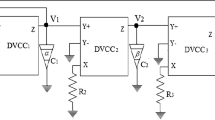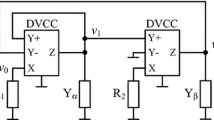Abstract
In this paper for the first time a catalogue of linear voltage-controlled fractional-order oscillators employing multiplication-mode current conveyor (MMCC) have been systematically derived using state variable approach. The work also includes detailed relevant analysis of the derived oscillators. Furthermore, three special cases are considered for each of the derived oscillators. Non-ideal analysis has been done for all the oscillators to show the impact of port non-idealities on the frequency. Port parasitics are also examined to justify the deviation between the theoretical and the simulated frequency values against the controlling voltage. Fourier analysis has been carried out to find out the total harmonic distortion figures. Functionality of all the oscillators have been verified on PSPICE utilizing the library files of AD844 and AD835 to realize MMCC. Simulation results are also provided for each special case including the integer-order case. Relevant MATLAB plots are provided for one of the oscillators to facilitate comparison between factional-order and oscillation parameters of the oscillator.










Similar content being viewed by others
References
Senani, R., Bhaskar, D. R., Singh, V. K., & Sharma, R. K. (2016). Sinusoidal oscillators and waveform generators using modern electronic circuit building blocks. New Delhi: Springer International Publishing. ISBN 978-3-319-23711-4.
Biolek, D., Senani, R., Biolkova, V., & Kolka, Z. (2008). Active elements for analog signal processing: Classification. Review, and New Proposals, Radio Engineering Journal,17(4), 15–32.
Hribsek, M. A. R. I. J. A., & Newcomb, R. (1976). VCO controlled by one variable resistor. IEEE Transactions on circuits and systems,23(3), 166–169.
Sundaramurthy, M., Bhattacharyya, B. B., & Swamy, M. N. S. (1977). A simple voltage controlled oscillator with grounded capacitors. Proceedings of the IEEE. https://doi.org/10.1109/PROC.1977.10784.
Senani, R., Bhaskar, D. R., & Tripathi, M. P. (1993). On the realization of linear sinusoidal VCOs. International Journal of Electronics,74(5), 727–733.
Bhaskar, D. R., & Senani, R. (1993). New current-conveyor-based single-resistance-controlled/voltage-controlled oscillator employing grounded capacitors. Electronics Letters,29(7), 612–614.
Chang, C. M. (1994). Novel current-conveyor-based single-resistance-controlled/voltage-controlled oscillator employing grounded resistors and capacitors. Electronics Letters,30(3), 181–183.
Liu, S. I. (1995). Single-resistance-controlled/voltage-controlled oscillator using current conveyors and grounded capacitors. Electronics Letters,31(5), 337–338.
Senani, R. (1996). New active-R sinusoidal VCOs with linear tuning laws. International Journal of Electronics,80(1), 57–61.
Gupta, S. S., & Senani, R. (1998). State variable synthesis of single resistance controlled grounded capacitor oscillators using only two CFOAs. IEE Proceedings Circuits, Devices and Systems,145(2), 135–138.
Bhaskar, D. R., & Tripathi, M. P. (2000). Realization of novel linear sinusoidal VCOs. Analog Integrated Circuits and Signal Processing,24(3), 263–267.
Galan, J., Carvajal, R. G., Torralba, A., Munoz, F., & Ramirez-Angulo, J. (2005). A low-power low-voltage OTA-C sinusoidal oscillator with a large tuning range. IEEE Transactions on Circuits and Systems I: Regular Papers,52(2), 283–291.
Gupta, S. S., Bhaskar, D. R., & Senani, R. (2009). New voltage controlled oscillators using CFOAs. AEU: International Journal of Electronics and Communications,63(3), 209–217.
Nandi, R., Kar, M., & Das, S. (2009). Electronically tunable dual-input integrator employing a single CDBA and a multiplier: Voltage controlled quadrature oscillator design. Active and Passive Electronic Components. https://doi.org/10.1155/2009/835789.
Bhaskar, D. R., Senani, R., & Singh, A. K. (2010). Linear sinusoidal VCOs: New configurations using current-feedback-op-amps. International Journal of Electronics,97(3), 263–272.
Bhaskar, D. R., Senani, R., Singh, A. K., & Gupta, S. S. (2010). Two simple analog multiplier based linear VCOs using a single current feedback op-amp. Circuits and Systems,1(1), 1–4.
Gupta, S. S., Bhaskar, D. R., Senani, R., & Singh, A. K. (2011). Synthesis of linear VCOs: The state-variable approach. Journal of Circuits, Systems and Computers,20(04), 587–606.
Gupta, S. S., Bhaskar, D. R., & Senani, R. (2012). Synthesis of new single CFOA-based VCOs incorporating the voltage summing property of analog multipliers. ISRN Electronics. https://doi.org/10.5402/2012/463680.
Pradhan, A., Subhadhra, K. S., Atique, N., Sharma, R. K., & Gupta, S. S. (2018). MMCC-based current-mode fractional-order voltage-controlled oscillators. IEEE International Conference on Inventive Systems and Control (ICISC). https://doi.org/10.1109/ICISC.2018.8398901.
Carlson, G., & Halijak, C. (1964). Approximation of fractional capacitors (1/s)^(1/n) by a regular Newton process. IEEE Transactions on Circuit Theory,11(2), 210–213.
Khoichi, M., & Hironori, F. (1993). H∞ optimized wave absorbing control: Analytical and experimental result. Journal of Guidance, Control and Dynamics,16(6), 1146–1153.
Oustaloup, A., Levron, F., Mathieu, B., & Nanot, F. M. (2000). Frequency-band complex noninteger differentiator: characterization and synthesis. IEEE Transactions on Circuits and Systems I: Fundamental Theory and Applications,47(1), 25–39.
Ahmad, W., El-Khazali, R., & Elwakil, A. S. (2001). Fractional-order Wien-bridge oscillator. Electronics Letters,37(18), 1110–1112.
Biswas, K., Sen, S., & Dutta, P. K. (2006). Realization of a constant phase element and its performance study in a differentiator circuit. IEEE Transactions on Circuits and Systems II: Express Briefs,53(9), 802–806.
Radwan, A. G., Soliman, A. M., & Elwakil, A. S. (2007). Design equations for fractional-order sinusoidal oscillators: Practical circuit examples. IEEE International Conference on Microelectronics. https://doi.org/10.1109/ICM.2007.4497668.
Radwan, A. G., Soliman, A. M., & Elwakil, A. S. (2008). Design equations for fractional-order sinusoidal oscillators: Four practical circuit examples. International Journal of Circuit Theory and Applications,36(4), 473–492.
Krishna, B. T., & Reddy, K. V. V. S. (2008). Active and passive realization of fractance device of order 1/2. Active and Passive Electronic Components. https://doi.org/10.1155/2008/369421.
Elwakil, A. (2010). Fractional-order circuits and systems: An emerging interdisciplinary research area. IEEE Circuits and Systems Magazine,10(4), 40–50.
Venkateswaran, P., Nandi, R., & Das, Sagarika. (2012). New integrators and differentiators using a MMCC. Circuits and Systems,3(3), 288–294.
Valsa, J., & Vlach, J. (2013). RC models of a constant phase element. International Journal of Circuit Theory and Applications,41(1), 59–67.
Nandi, R., Venkateswaran, P., & Kar, Mousiki. (2014). MMCC based electronically tunable all pass filters using grounded synthetic inductor. Circuits and Systems,5(4), 89–97.
Said, L. A., Radwan, A. G., Madian, A. H., & Soliman, A. M. (2016). Fractional-order oscillator based on single CCII. IEEE International Conference on Telecommunications and Signal Processing (TSP). https://doi.org/10.1109/TSP.2016.7760952.
Comedang, T., & Intani, P. (2016). Current-controlled CFTA based fractional order quadrature oscillators. Circuits and Systems,7(13), 4201–4212.
El-Naggar, A. M., Said, L. A., Radwan, A. G., Madian, A. H., & Soliman, A. M. (2017). Fractional order four-phase oscillator based on double integrator topology. IEEE International Conference on Modern Circuits and Systems Technologies (MOCAST). https://doi.org/10.1109/MOCAST.2017.7937685.
Said, L. A., Radwan, A. G., Madian, A. H., & Soliman, A. M. (2017). Generalized family of fractional-order oscillators based on single CFOA and RC network. IEEE International Conference on Modern Circuits and Systems Technologies (MOCAST). https://doi.org/10.1109/MOCAST.2017.7937641.
El-Naggar, A. M., Said, L. A., Radwan, A. G., Madian, A. H., & Soliman, A. M. (2017). Fractional order four-phase oscillator based on double integrator topology. IEEE International Conference on Modern Circuits and Systems Technologies (MOCAST). https://doi.org/10.1109/MOCAST.2017.7937685.
Said, L. A., Radwan, A. G., Madian, A. H., & Soliman, A. M. (2017). Three fractional-order-capacitors-based oscillators with controllable phase and frequency. Journal of Circuits, Systems and Computers. https://doi.org/10.1142/S0218126617501602.
Said, L. A., Radwan, A. G., Madian, A. H., & Soliman, A. M. (2015). Fractional order oscillators based on operational transresistance amplifiers. AEU-International Journal of Electronics and Communications,69(7), 988–1003.
Senani, R., & Gupta, S. S. (1997). Synthesis of single-resistance-controlled oscillators using CFOAs: simple state-variable approach. IEE Proceedings-Circuits, Devices and Systems,144(2), 104–106.
Hwang, Y.-S., Tu, S.-H., Liu, W.-H., & Chen, J.-J. (2009). New building block: Multiplication-mode current conveyor. IET Circuits, Devices and Systems,3(1), 41–48.
Wu, J., & El-Masry, E. (1996). Current-mode ladder filters using multiple output current conveyors. IEE Proceedings-Circuits, Devices and Systems,143(4), 218–222.
Gupta, S. S., & Senani, R. (1998). State variable synthesis of single-resistance-controlled grounded capacitor oscillators using only two CFOAs: Additional new realisations. IEE Proceedings-Circuits, Devices and Systems,145(6), 415–418.
Caponetto, R., Dongola, G., Fortuna, L., & Petras, I. (2010). Fractional order systems: Modeling and control applications. World Scientific Series on Nonlinear Science Series A,72, 178.
Data-sheet and SPICE library file of AD835 and AD844, Analog Devices, USA.
Author information
Authors and Affiliations
Corresponding author
Additional information
Publisher's Note
Springer Nature remains neutral with regard to jurisdictional claims in published maps and institutional affiliations.
Appendix: Derivation of state matrix coefficients for FO-VCO 2.3 of Table 2
Appendix: Derivation of state matrix coefficients for FO-VCO 2.3 of Table 2

By utilizing MMCC’s terminal relationship as given in Eq. (1) and voltage across C1 as x1 and across C2 as x2, we can write KCL at the nodes of C1 and C2 as
which can be rearranged as
Similarly, Eq. 22 can be rearranged as
Comparing Eqs. (20) and (23) with Eq. (3) the coefficients of the state matrix can be obtained as follows
Rights and permissions
About this article
Cite this article
Subhadhra, K.S., Sharma, R.K. & Gupta, S.S. Realisation of some current-mode fractional-order VCOs/SRCOs using multiplication mode current conveyors. Analog Integr Circ Sig Process 103, 31–55 (2020). https://doi.org/10.1007/s10470-020-01590-4
Received:
Revised:
Accepted:
Published:
Issue Date:
DOI: https://doi.org/10.1007/s10470-020-01590-4




